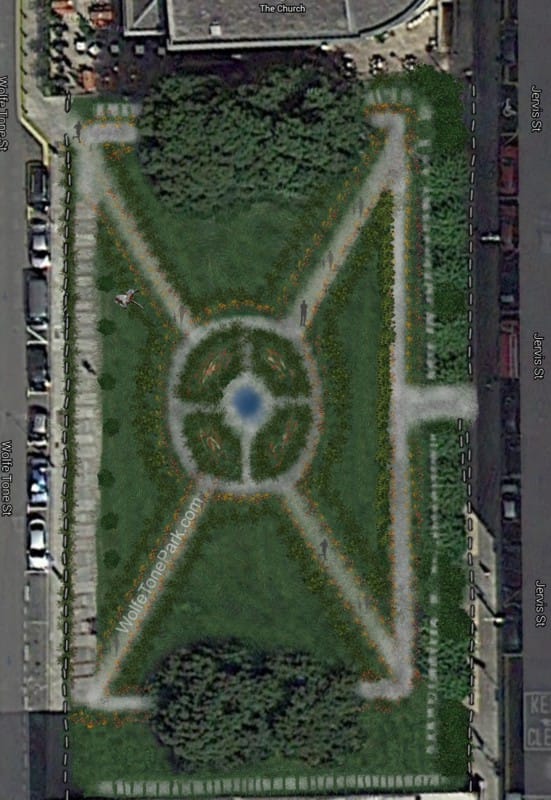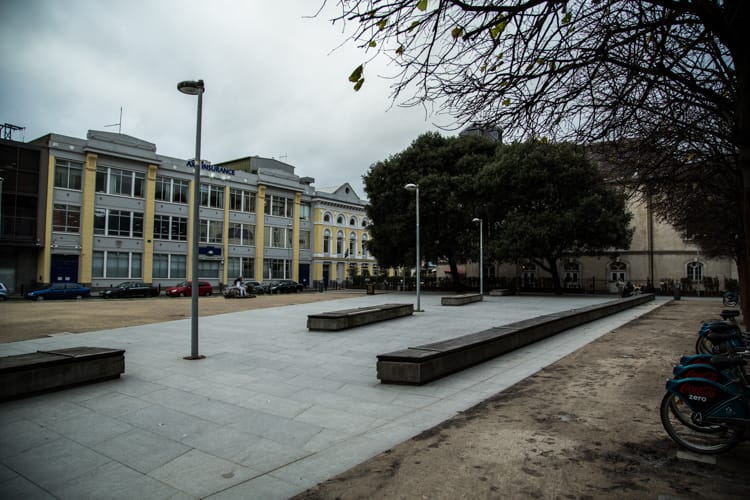Nobody caught illegally dumping yet by new north inner-city CCTV
But the scheme is a success, said a council official's report, as that shows the cameras are a deterrent.
If all goes as planned, we will see Dublin City Council’s draft proposal for Wolfe Tone Park early next year. Should it include a new cafe?

In recent months, the Wolfe Tone Park community has upped its campaign to have the cold, concrete space returned to its previous state: a pleasant, welcoming green oasis for the city.
And so far, the group – which is made up of residents of the Wolfe Tone Street/Jervis Street area – has had some success.
Of the 11 objectives it set out on its website, the group has achieved seven. These include removing commercial furniture and the council’s prefab staff toilets, as well as ending amplified music events in the park, which were a heart-scald for locals.
The last event to take place was Dublin Fringe Festival’s Spiegeltent in September. It featured a brass band, and at times noise levels reached 96.6 decibels inside some nearby apartments – similar to what you’d hear if you were standing near a jackhammer.
After Dublin City Council received a barrage of complaints from residents about the noise, Assistant Chief Executive Brendan Kenny appeased them. In an email, he assured locals that the Spiegeltent would not be permitted in the park by the council in future, and that no more daytime or night-time events would take place in the park.
That same month, the restoration of the park was included in the draft Dublin City Development Plan, which states that it is an objective of the council to implement a conservation plan for Wolfe Tone Park.
These two victories for the residents seemed like progress towards another one of their stated goals: to prevent any commercial operations in the park.
But little did they know that there would be no more room for circus tents or raucous events anyway, because plans to install a café were coming down the line.
At last Tuesday’s Central Area Committee meeting, the councillors present unanimously agreed to grant a three-year concession to The Tram Café.
If passed by councillors at next month’s city-wide meeting, the café will operate from a 1920s-style tram based in Wolfe Tone Park.
Some councillors, though, are already having second thoughts.
Fine Gael councillor Ray McAdam voted in favour of the café, and he is satisfied that the council will conserve the park and return it to its former, green glory, as promised.
“It would be fantastic to see it brought back to how it was in the late 1800s,” he said.
But now he seems less certain that the vote in favour of the tram café was a wise decision. He isn’t convinced there’s a need for a café there.
Independent councillor Mannix Flynn arrived to the Tuesday meeting late after he was informed of this proposal. Although he’s a councillor for another area of the city, he is determined that the park remain free from commercial activities.
Surely, Dublin can have one space that isn’t totally commercialised, he said, pointing out that the Church Bar adjoining the park has a café.
“I really think there’s a very strong case to restore the park to the way it was . . . It’s smack-bang in the middle of town, and it would be a fantastic place for it,” he said.
He is dismayed that councillors approved the proposal for the café, and that the parks department has put this forward before the conservation plan.
The Wolfe Tone Park Community weren’t too happy with this development either, because it doesn’t fit in with what they had envisaged for the park.
“The tram café is a major concern for us here. We have thousands of options to buy a cup of tea . . . We are determined that Wolfe Tone Park is developed as a public amenity, free from commercial activity,” said Ciarán Flynn, a resident who has lived across from the park for more than 15 years.

A vision for the park put together by some local residents.
The group’s ultimate goal was to have the park restored to the way it used to be, with grassy greens, walkways and the old fences, which the council still has in storage. Alternatively, the residents had agreed upon a design proposal for a traditional park layout with a simple water feature at the centre.
This would come in at a cost of €50,000, the same amount McAdam understands has been set aside by the council for the redesign in its 2016 budget.
“Once inside the gate, visitors could meander through the paths as they explore the perimeter headstones,” said Flynn. “This becomes a very different experience than the present prison-yard layout.”
A tram, he says, wouldn’t fit into either of these layouts.
Green Party councillor Ciarán Cuffe missed the vote at last week’s meeting, but later on he voiced his concerns over not being invited to the consultations that took place regarding the future of the park.
“I consider myself a stakeholder for Wolfe Tone Park . . . and I think our opinions are of value in this process. I’m a bit worried about being sidelined,” he said. McAdam also voiced concerns about the consultation process.
Instead, councillors were presented with feedback from what council management called “World Café Day”. Held on March 10, this was a meeting of the park’s stakeholders, at which they were invited to suggest future plans for the space.
Councillors at last week’s meeting were clearly under the impression that local residents attended the event.
“The local residents were at the world café,” said the chair of the meeting, independent councillor Nial Ring.
But the councillors weren’t there.
In fact, there was just one local resident there for the feedback session, a spokesperson for Dublin City Council confirmed.
The other stakeholders present were mostly business owners, council management and a representative of the local Garda station.
Some of the feedback presented to councillors argued that the city already has green Georgian spaces, and that Wolfe Tone Park needn’t follow suit.

Ciarán Flynn was the resident at the March meeting. He showed up uninvited, he said.
There was a campaign by residents to restore grass to the park in 2006, but this came to nothing.
It was this meeting in March which reignited the campaign, when Flynn became concerned that the park might be targeted for commercial use. He even mentioned worries over suggestions of a café.
Social Democrat councillor for the area Gary Gannon said that no residents had been in touch with him over any concerns about the park.
He would like to see more greenery in the space, but isn’t opposed to the idea of the Tram Café. As he sees it, it would be an extra amenity for people.
“The fact that it’s going to be a tram, means it will show a bit of our history and help to pass on our heritage,” he said.
Last Friday, councillors for the area met with the parks superintendent, Les Moore. They were told that final proposals to improve the park are being drawn up and will include more tree and grass planting.
“I am pleased to hear this,” said Cuffe, of the Green Party.
However, the park is unlikely to be completely covered in grass, said Sinn Féin councillor Janice Boylan. “People have gotten used to cutting through there.”
Plans are still in the early stages, said Boylan. But there were suggestions that the gravestones be buried and a plaque put in place to remember the dead, instead.
She is in favour of the Tram Café as well.
“The way I look at it is, it will bring a bit of footfall to the area. It will encourage people to come into and use the park,” she said.
The draft proposals are due to be presented to the central area committee early next year.